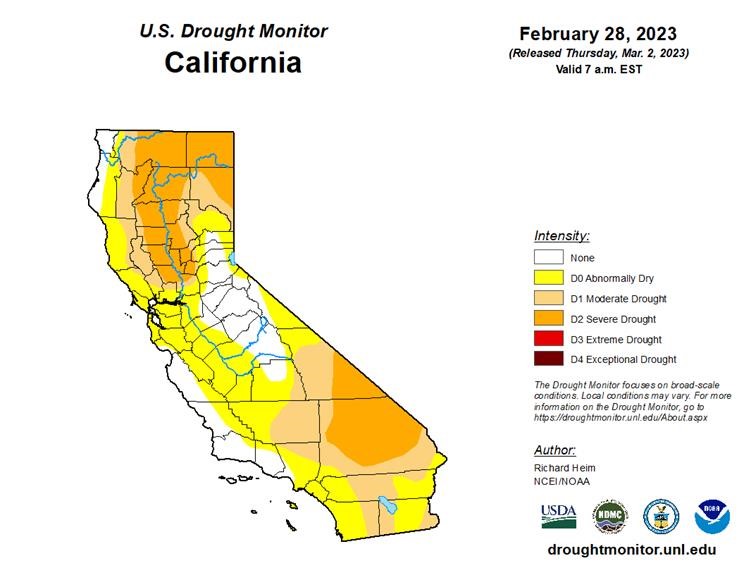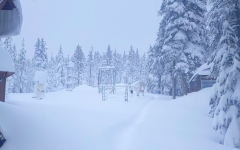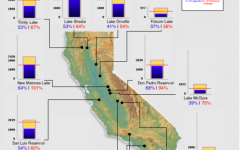
February 2023 California Drought levels (Photo: U.S. Drought Monitor https://droughtmonitor.unl.edu)
Half of California No Longer Under Drought Conditions
Reservoirs across state quickly returning to pre-drought levels
By Evan Symon, March 3, 2023 1:31 pm
According to new data released by the U.S, Drought Monitor on Thursday, only half the state is currently under drought conditions following the recent storms earlier this week, with no part of the state now at ‘extreme drought’ levels for the first time in over a year.
Since the late 2010’s, California has had megadrought conditions across the state resulting in water restrictions in both urban and agricultural areas, as well as record lows in reservoir levels across the state. In 2022, many predicted an even drier 2023, with even more restrictions coming to help preserve water.

However, in late December, bomb cyclones began to fall on the state and didn’t let up until mid-January. Snowpack levels in the mountains, critical for water stocks later in the year, increased exponentially. Reservoirs started to fill up again. Farms left fallow for the last year or two saw dormant seeds begin to sprout early. When skies finally cleared, snowpack levels across the state stood at an average of 250%, with reservoirs coming back close to normal levels once again. While some restrictions were kept due to water experts not knowing what the rest of the year would bring, the bomb cyclones put California at a good place when it came to battling the drought.
Late last month, another wave of storms brought even more rain, with the LA-area seeing its most significant snowfall since 1989. Snow was found on the Hollywood sign, with San Bernardino County seeing so much that the mountains became inaccessible and major highways like Interstate 5 had to shut down for a time.
Like the bomb cyclones earlier this year, the added precipitation significantly eased the drought conditions that have been prevalent in the state for years. On Thursday, the U.S. Drought Monitor, a joint U.S. Governmental partnership between the United States Department of Agriculture and the National Oceanic and Atmospheric Administration, found that no parts of the state were under ‘extreme drought conditions’ anymore. In addition, the February storms officially brought about half the state to being classified as having no drought issues or as “abnormally dry.”
Half of California no longer under drought conditions
Reservoirs have seen improvement as well. In January, Lake Shasta stood at 57% of it’s normal levels, with Lake Oroville at 71%. This week, Shasta was at 84%, with Oroville brimming up to 116%. Snowpack also had significant figures. A month before the critical April 1st measuring date, which has historically needed the snowpack to be at 100% to have an adequate amount of melt for the rest of the year, levels across the state varied, with some ranges approaching 300%. Tahoe came in just below 200%. It’s the deepest it has been in decades, with some areas closing in on all time recorded records.

Water experts noted on Friday that the added precipitation would help ease drier conditions likely for this year, and would likely not bring on some of the more drastic water restrictions that have been imposed in recent years.
“We just keep getting water,” explained Jack Wesley, a water systems consultant for farms and multi-family homes, to the Globe on Friday. “No one predicted last year that we would see floods or snow in LA or anything like this. Everyone thought it was just going to be another dry year with bat-tub ringed reservoirs being the norm. But now look where we are.”
“I still think restrictions will be in place to some degree, especially since we know now to better manage water in case of another long stretch of drought, but honestly, that’s a good thing. We’re being more careful and being more strategic on what to use. We have more people questioning the need for environmental water use, such as letting water out solely to help fish populations. We have farmers working on how to best stretch their allotments and use what they have to the best of their ability. We have people in cities not watering every day and being more careful on when they water. We have new sources, such as desalinization plants, being heavily considered as future sources.”
“But, right now, we are looking in good shape for this year. Reservoirs are looking good, groundwater is being recharged, and we have a lot of snow in the mountains. This is going to be a rebound year for sure, especially if we get some more storms in there before summer hits. We’re getting out of the drought. California hasn’t gotten a lot of good news lately, but we finally have some.”
More storms are likely to affect California before the snowpack is measured again on April 1st.
- New Reports Finds EPA Will Likely Give A Waiver For California’s 2035 Gas-Powered Car Sales Ban Mandate - December 14, 2024
- Port Of Oakland Appeals Temporary Court Ruling Blocking use of ‘San Francisco Bay’ In Name - December 13, 2024
- Farmers Insurance to Increase Number Of Homeowner & Renter Policies in California - December 12, 2024





Record breaking rain and snow won’t stop Newsom and Democrats from insisting that there’s still a drought emergency and water restrictions cannot be lifted? They’ll release so much water from reservoirs that by summer the reservoirs will be at low levels again? Newsom and Democrats want permanent water scarcity to keep their iron fisted control over Californians?
None the less I still thank God for the water. He will take care of the Demonrats.
Thank you, Lord for answered prayers about sending us the rain & re-filling our water resources….
(And the best part is that there’s more anticipated in a week or so…and then all the snow-melt….)
But watch our jackwagon Governor and his mis-management team find a way to waste the precious resources and execute their World Economic Forum/CCP plans to starve out our farmers and create the artificial/politically-motivated shortages that enable their “emergency” declarations, and restrictive controls….
Work off the presumption that everything a govt entity has reported has always been by design, in accordance with the globalist agenda. Common sense, intuition, and reporting by independent scientists and researchers has more
validity. Set your intentions that the water being delivered is pure, healing, abundant, and free.